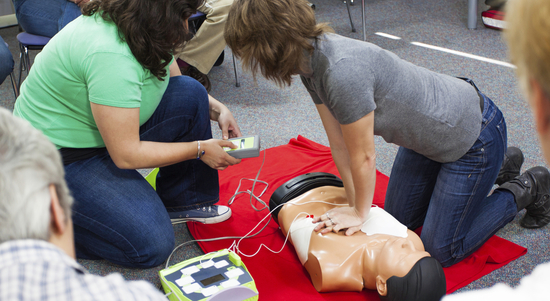Introduction
In emergency situations, every 2nd counts-- specifically when it comes affordable first aid adelaide to conserving lives. The act of executing chest compressions throughout a heart attack can mean the difference in between life and fatality. This post delves into the intricacies of Mastering Compressions: Taking Transforms to Conserve Lives, highlighting the significance of synergy, proper method, and expertise of protocols that can improve survival prices in essential situations. By the end of this thorough overview, you will have a deeper understanding of not just basic vs sophisticated life assistance, however additionally just how taking turns on compressions can optimize rescue efforts.
Mastering Compressions: Taking Transforms to Save Lives
When it concerns mouth-to-mouth resuscitation (cardiopulmonary resuscitation), mastering compressions is crucial. Upper body compressions are the heart of mouth-to-mouth resuscitation, actually The original source and figuratively. They preserve blood flow to vital body organs when the heart stops working, offering time for emergency solutions to show up and take over. Nonetheless, many people are uninformed that taking turns throughout compressions can significantly enhance effectiveness and effectiveness.
The Relevance of Chest Compressions
- What are Breast Compressions? Chest compressions are rhythmic presses put on the sternum, aiming to mimic the heart's pumping action. Why Are They Critical? During cardiac arrest, blood flow stops. Without immediate treatment, brain damage and fatality can occur within minutes.
Basic vs Advanced Life Support
Understanding the distinction between basic vs sophisticated life support is crucial for any individual aiming to give support in an emergency.
- Basic Life Assistance (BLS) Often taught in CPR training courses, BLS includes upper body compressions, rescue breaths (if trained), and making use of an AED (Automated External Defibrillator). Advanced Life Support (ALS) ALS includes much more intricate procedures like airway monitoring and medication management by experienced healthcare professionals.
Checking Responsiveness: The First Step
Before starting any life-saving procedures, checking responsiveness is essential.
- How to Check Responsiveness? Gently tremble the individual's shoulders while asking if they are okay. If there's no reaction, call for emergency assistance immediately.
Hospital Codes and Protocols
Every hospital runs under particular codes that determine exactly how emergency situations must be handled.
- What are Healthcare facility Codes? Codes like "Code Blue" commonly indicate a person requiring resuscitation. Why Know These Codes? Understanding methods makes sure that your actions align with medical facility plans during an emergency situation situation.
Public Defibrillator Use: A Lifesaver
Public gain access to defibrillators play a considerable duty in raising survival rates throughout cardiac arrests.
- How Do You Use One? Locate a close-by AED. Turn it on and adhere to voice prompts. Ensure nobody is touching the person when providing a shock.
BLS Certification: Why It Matters
Obtaining your BLS qualification is very useful for both laypersons and medical care providers.
- Where Can You Get Certified? Many companies like the American Heart Association deal courses at numerous levels.
Identifying No Breathing: A Critical Skill
Knowing exactly how to Click here for more info identify whether a person is breathing is important prior to initiating CPR.
- What Does No Breathing Look Like? Lack of typical breathing patterns; try to find wheezing or no motion at all.
Taking Switches on Compressions: A Team Effort
When several rescuers exist, revolving functions throughout breast compressions can prevent fatigue.
Benefits of Taking Turns
Maintains top notch compressions. Prevents rescuers from ending up being exhausted. Enhances control among team members.Lower Compression Deepness: Is It Effective?
While there's a standard for compression deepness (a minimum of 2 inches), some might question reduced midsts in specific situations.
- Is Lower Compression Depth Effective? No-- staying with suggested guidelines is vital for reliable blood circulation during CPR.
Slow Compression Rate: What's Optimal?
A typical false impression is that slower prices could be more reliable; however:
- The excellent rate for upper body compressions is in between 100-- 120 per minute.
FAQ Section
1. What must I do if I see someone collapse?
Start by examining responsiveness-- shout their name or give them a gentle shake. If there's no feedback, phone call emergency solutions immediately.

2. How much time should I carry out CPR?
Continue till emergency situation -responders arrive or an AED is readily available; preferably till you're too worn down or somebody else can take over.

3. Can I do CPR on children?
Yes! The strategy is similar but with lowered force-- make use of one hand as opposed to 2 for smaller children if needed.
4. Where can I learn more about BLS certification?
Check regional health centers or wellness organizations; numerous offer courses frequently customized toward different ability levels.
5. What if I'm alone when a person requires help?
If you're alone with an adult that's less competent however breathing generally, call emergency solutions prior to beginning mouth-to-mouth resuscitation; if they're not breathing-- begin right away!
6. Is public defibrillator usage safe?
Absolutely! AEDs are developed for layperson use with basic directions offered through audio motivates-- do not hesitate!
Conclusion
Mastering Compressions: Taking Transforms to Save Lives stresses greater than just executing breast compressions; it embodies synergy, understanding of methods, and knowledge concerning devices like AEDs that jointly contribute in the direction of saving lives in emergency situations. Whether you're accredited or just wish to be prepared for unforeseen circumstances, understanding these ideas will equip you as an initial -responder in defining moments. Bear in mind-- the ability to act with confidence can change concern right into activity when it matters most!